Related Research Articles
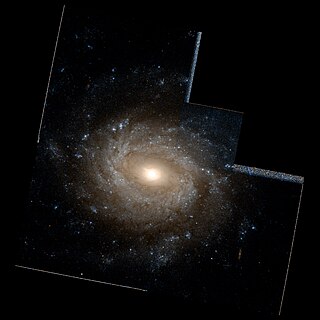
NGC 3486 is an intermediate barred spiral galaxy located about 27.4 million light years away in the constellation of Leo Minor. It has a morphological classification of SAB(r)c, which indicates it is a weakly barred spiral with an inner ring and loosely wound arms. This is a borderline, low-luminosity Seyfert galaxy with an active nucleus. However, no radio or X-ray emission has been detected from the core, and it may only have a small supermassive black hole with less than a million times the mass of the Sun.
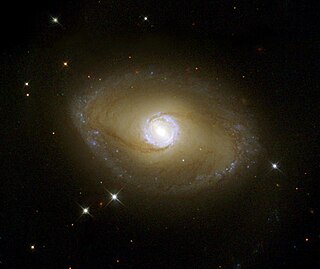
NGC 6782 is a barred spiral galaxy located in the southern constellation of Pavo, at a distance of approximately 173 megalight-years from the Milky Way. It was discovered on July 12, 1834 by English astronomer John Herschel. John L. E. Dreyer described it as, "considerably faint, considerably small, round, a little brighter middle, 9th magnitude star to south". The morphological classification of NGC 6782 is (R1R′2)SB(r)a, indicating a barred spiral galaxy with a multiple ring system and tightly-wound spiral arms. It is seen nearly face-on, being inclined by an angle of 27.2°±0.2° to the line of sight from the Earth.
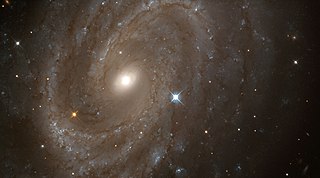
NGC 4603 is a spiral galaxy located about 107 million light years away in the constellation Centaurus. It is a member of the Centaurus Cluster of galaxies, belonging to the section designated "Cen30". The morphological classification is SA(s)c, which indicates it is a pure spiral galaxy with relatively loosely wound arms.

NGC 3344 is a relatively isolated barred spiral galaxy located 22.5 million light years away in the constellation Leo Minor. This galaxy belongs to the group known as the Leo spur, which is a branch of the Virgo Supercluster. NGC 3344 has the morphological classification (R)SAB(r)bc, which indicates it is a weakly barred spiral galaxy that exhibits rings and moderate to loosely wound spiral arms. There is both an inner and outer ring, with the prominent arms radiating outward from the inner ring and the slightly elliptical bar being situated inside. At the center of the bar is an HII nucleus with an angular diameter of about 3″. NGC 3344 hosted supernova SN 2012fh, which was shown to likely be a Type Ib or Type Ic.

NGC 5821 is a spiral galaxy with a ring structure in the constellation Boötes. It lies near a similarly massed galaxy, NGC 5820, at the same redshift. Both galaxies were discovered by the astronomer William Herschel.

NGC 5614 is an unbarred spiral galaxy in the constellation Boötes. It is the primary member of the Arp 178 triplet of interacting galaxies with NGC 5613 and NGC 5615.

NGC 5545 is a spiral galaxy in the northern constellation of Boötes. It is interacting with the barred spiral galaxy NGC 5544.

NGC 5754 is a barred spiral galaxy located 218 million light years away in the constellation Boötes. It is a member of the Arp 297 interacting galaxies group, which consists of NGC 5752, NGC 5753, NGC 5754, NGC 5755. Along with NGC 2718 and UGC 12158, NGC 5754 is often considered a Milky Way-twin.
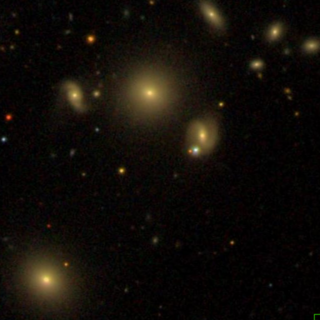
NGC 3554 is an elliptical galaxy in the constellation Ursa Major. It was discovered in December 1827 by John Herschel.

NGC 3268 is an elliptical galaxy in the constellation Antlia. It is a member of the Antlia Cluster, which lies about 40.7 megaparsecs away. It was discovered on April 18, 1835 by the astronomer John Herschel.

NGC 3258 is an elliptical galaxy in the constellation Antlia. It is a member of the Antlia Cluster, which lies about 40.7 megaparsecs away. It was discovered on May 2, 1834 by John Herschel.

NGC 3281 is a large unbarred spiral galaxy in the southern constellation of Antlia, located at a distance of 144.7 megalight-years from the Milky Way. The galaxy is inclined by an angle of 64° to the line-of-sight from the Earth, with the major axis aligned with a position angle of 137°. It is a luminous infrared galaxy and a type II Seyfert galaxy. NGC 3281 is a member of the Antlia Cluster, which belongs to the Hydra–Centaurus Supercluster.

NGC 1728 is a spiral galaxy in the constellation Eridanus. The galaxy is listed in the New General Catalogue. It was discovered on November 10, 1885 by the astronomer Edward Emerson Barnard.
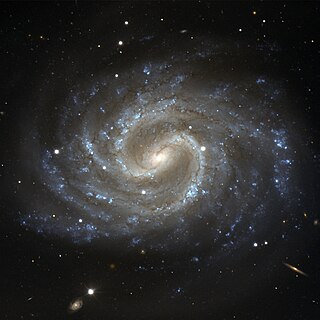
NGC 4535 is a barred spiral galaxy located some 54 million light years from Earth in the constellation Virgo. It is a member of the Virgo Cluster of galaxies and is located 4.3° from Messier 87. The galactic plane of NGC 4535 is inclined by an angle of 43° to the line of sight from the Earth. The morphological classification of NGC 4535 in the De Vaucouleurs system is SAB(s)c, which indicates a bar structure across the core (SAB), no ring (s), and loosely wound spiral arms (c). The inner part of the galaxy has two spiral arms, which branch into multiple arms further away. The small nucleus is of type HII, meaning the spectrum resembles that of an H II region.

NGC 4698 is a barred spiral galaxy located around 55 million light years away from Earth in the constellation of Virgo. It belongs to the Virgo Cluster of galaxies and is positioned near the northeastern edge of this assemblage. The morphological classification of NGC 4698 in the De Vaucouleurs system is SA(s)ab, which indicates a purely spiral structure with moderate to tightly wound arms. It is inclined to the line of sight from the Earth by an angle of 53° along a position angle of 170°.

NGC 4293 is a lenticular galaxy in the northern constellation of Coma Berenices. It was discovered by English astronomer William Herschel on March 14, 1784, who described it as "large, extended, resolvable, 6 or 7′ long". This galaxy is positioned to the north-northwest of the star 11 Comae Berenices and is a member of the Virgo Cluster of galaxies. It is assumed to lie at the same distance as the Virgo Cluster itself: around 54 million light years away. The galaxy spans an apparent area of 5.3 × 3.1 arc minutes.

NGC 159 is a barred lenticular galaxy in the constellation Phoenix. The galaxy was discovered on October 28, 1834, by John Frederick William Herschel.
ESO 235-58 is a galaxy in the constellation of Indus.

NGC 1326 is a lenticular galaxy in the constellation Fornax, 63 million light-years away. It was discovered by English astronomer John Herschel on 29 November 1837. It is a member of the Fornax Cluster, an NGC 1316 subgroup and has a diameter of 70 000 light-years.

NGC 1570, mistakenly called NGC 1571, is a faint galaxy located in the southern constellation Caelum, the chisel. It has a blue magnitude of 13.2, making it visible through a medium sized telescope. Based on a redshift of z = 0.014760, the object is estimated to be 198 million light years away from the Local Group. It appears to be receding with a heliocentric radial velocity of 4,392 km/s.
References
- 1 2 3 Skrutskie, Michael F.; Cutri, Roc M.; Stiening, Rae; Weinberg, Martin D.; Schneider, Stephen E.; Carpenter, John M.; Beichman, Charles A.; Capps, Richard W.; Chester, Thomas; Elias, Jonathan H.; Huchra, John P.; Liebert, James W.; Lonsdale, Carol J.; Monet, David G.; Price, Stephan; Seitzer, Patrick; Jarrett, Thomas H.; Kirkpatrick, J. Davy; Gizis, John E.; Howard, Elizabeth V.; Evans, Tracey E.; Fowler, John W.; Fullmer, Linda; Hurt, Robert L.; Light, Robert M.; Kopan, Eugene L.; Marsh, Kenneth A.; McCallon, Howard L.; Tam, Robert; Van Dyk, Schuyler D.; Wheelock, Sherry L. (1 February 2006). "The Two Micron All Sky Survey (2MASS)". The Astronomical Journal. 131: 1163–1183. doi:10.1086/498708. ISSN 0004-6256.
- 1 2 Crook, Aidan C.; et al. (February 2007). "Groups of Galaxies in the Two Micron All Sky Redshift Survey". The Astrophysical Journal. 655 (2): 790–813. arXiv: astro-ph/0610732 . Bibcode:2007ApJ...655..790C. doi:10.1086/510201.
- ↑ "ESO 603-G21". SIMBAD . Centre de données astronomiques de Strasbourg . Retrieved 2020-01-12.
- ↑ Reshetnikov, V. P.; Faúndez-Abans, M.; de Oliveira-Abans, M. (February 2002). "ESO 603-G21: A strange polar-ring galaxy". Astronomy & Astrophysics. 383 (2): 390–397. arXiv: astro-ph/0112351 . doi:10.1051/0004-6361:20011784.